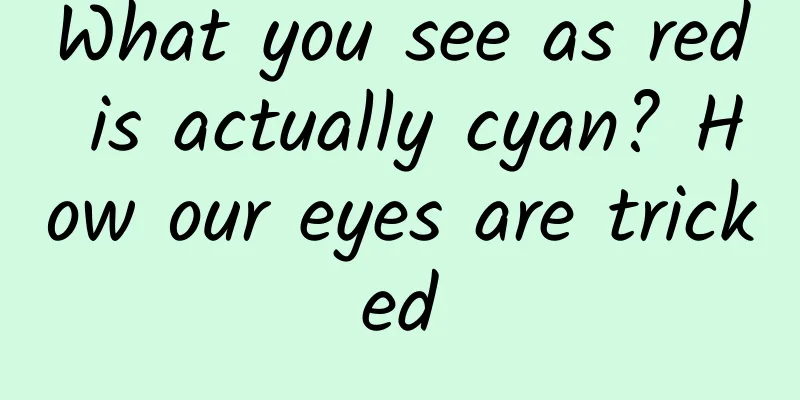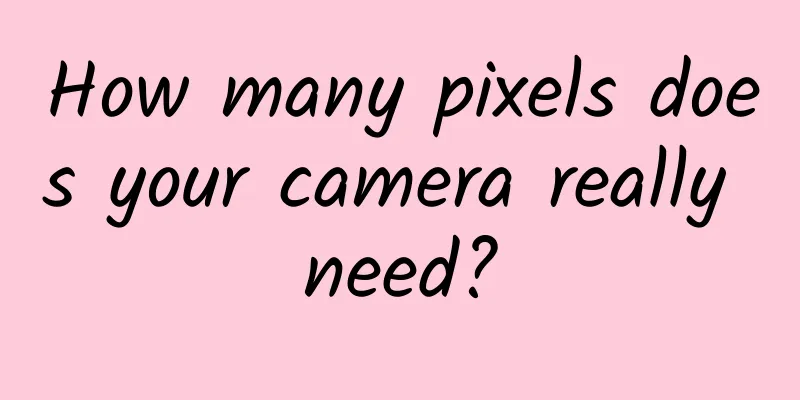What you see as red is actually cyan? How our eyes are tricked

|
First, let's look at a picture together. Is there a can of red Coca-Cola in the picture? Some people will say, I believe my eyes, it is absolutely true, there must be one. But don't be impatient, after enlarging this picture on your phone or computer screen, look back and take a closer look, do you feel that something is wrong? There seem to be only some black, white and dark blue lines in it, but there is no real red. But when the picture is reduced to its original shape, the red Coke can appears again. How can we explain this strange phenomenon that is both real and illusory? Is it true that if we have goodness in our hearts, we see light; if we have evil in our hearts, we see darkness; if we have Coca-Cola in our hearts, we see red cans? If your vision deceives you, don't be sad or anxious. Light Science will answer your questions about optics. It is not uncommon for a photo to show colors that appear out of nowhere. This is related to the way the photo itself represents color information. Whether it is a camera, a display, a printer, or a projector, all kinds of digital imaging devices use pixel arrays to represent a picture. To put it simply, the entire picture is composed of many small squares as basic units. Each small square is called a pixel and has its own color. Twenty or thirty years ago, the image quality of early video game consoles was rough, the resolution was low, and the size of each pixel was large. The image always had a "grid feel", like a mosaic. Later, with the development of display technology, the number of pixels in a picture increased, and the size of each pixel became smaller, so the whole picture looked more and more realistic, and the individual pixels seemed to be invisible, but the pixel array form remained the same. Of course, driven by the retro trend, the popular NFT avatars represented by CryptoPunk will still give you a clear "pixel sense" (the professional name of NFT is Non-Fungible Token, non-homogeneous token). We often talk about black-and-white photos and color photos, black-and-white movies and color movies. In fact, "black-and-white" should refer to "grayscale". Although there is no color, it has a continuous transition from full black, dark gray, medium gray, light gray to full white (specifically, it can be represented by grayscale values 0 to 255), which can also bring a considerable degree of image effect and expressiveness. For example, the director of the famous movie "Schindler's List" in the 1990s deliberately used grayscale effects without color in most of the pictures. But sometimes, due to technical limitations, true grayscale is impossible. For example, a simple printer or display can only display full black (0) and full white (255) in each pixel, which is equivalent to having only two brushes, pure black and pure white. It can be called a true "black and white" binary display. Even a good cook cannot cook without rice. If you want to draw a photo with different shades of gray in different positions, you need to use your brain. For example, if we want to display this grayscale photo of a foreign guy, if we directly approximate the grayscale values of different pixels to pure black or pure white, the light gray will be "rounded" to white and the dark gray will be "rounded" to black. The final result is as terrible as the second picture, a whole "clown face". The third picture looks much more comfortable, as if the grayscale depth is variable and there are not only two colors, black and white. But if you look closely, there are still only these two types of pixels. It's just that an algorithm called "error diffusion" [1] is used to reasonably control the black and white pixel ratio in different areas. The relatively dense black points represent the dark area, and the relatively dense white points represent the bright area. The spatial distribution is exchanged for the accuracy of color depth representation. It is like magic, bringing a complete grayscale viewing experience. The same can be done by using a limited number of brushes to create a myriad of colors. In color display, red, green, and blue are the three primary colors. Red and green light can produce yellow light, green and blue light can produce cyan light, and red and blue light can produce purple light. The result of mixing all three primary colors together is white light. Ideally, a pixel can produce red, green, and blue (RGB) primary colors at the same time, and the intensity of the three channels can be freely adjusted, so that various colors can be easily mixed. But ideals are beautiful, and reality is skinny. If a pixel can only display red or blue alone, how can it match purple? In the following checkerboard patterns, each square is red or blue, with a 1:1 ratio. From left to right, as the grid becomes smaller, the pixels become smaller and denser, and it seems that the red and blue are gradually disappearing, and finally the whole pattern turns purple. This is actually wrong! All pixels in all patterns (including the rightmost pattern) are only red and blue. Purple is an illusion caused by the human eye fusing red and blue pixels, or perceiving a color that does not exist. In the left picture below, each pixel has only 256 possible colors, which makes it difficult to express richer color levels. However, after the pixels are distributed more reasonably, the picture on the right becomes obviously more pleasing to the eye. We can get new colors "out of nothing" through the spatial distribution of a limited number of color pixel positions, and the time dimension is another way. To give a simple example, many people must have played such a game when they were young. Make a small disc with cardboard, paint the small disc alternately with red and yellow, and then put a small pillar in the middle of the small disc, let the small disc spin quickly like a gyroscope, what will you see? That's right, the small disc is neither red nor yellow, but the red and yellow colors quickly "shift" flashed in front of your eyes, and were "adjusted" to the orange in the middle. When the display screen plays a video, it is actually equivalent to dozens of static pictures flashing quickly in sequence per second, and the human eye happens to have a visual persistence effect, which overlaps them together. In this way, the two primary colors are displayed alternately and quickly, which can naturally deceive your eyes to see the new color after fusion. In fact, the image processing tricks mentioned above have a special name: dithering. This story started decades ago during World War II. At that time, electronic computers had not yet been invented. The U.S. military bombers could only use mechanical computers to calculate flight directions and bombing curves. A large box contained a large number of gears and lever parts. Although the calculation accuracy was not very good, it was also quite delicate and afraid of being bumped and dropped. It was not as comfortable to go up and down in the cockpit of a bomber as sitting on the sofa at home. People were most worried that the violent shaking would shake off a few parts, making the mechanical computer unable to work, and the plane would lose its course. If the bomb was accidentally dropped on its own position, it would be a big trouble. However, this kind of computer is quite competitive. It did not break on the plane, and surprisingly, the calculation results were more accurate than when it was used safely on the ground, which was puzzling. Since it has this "strange temper", engineers once specially designed a vibrator to simulate the flight state, so that the mechanical computer can also experience the feeling of flying on the ground to improve the calculation accuracy. Why do these things work better after shaking them on the plane? The main reason is that the early mechanical parts are not as accurate to many decimal places as the current computers, but only have a limited number of digits. Assuming that it can only be accurate to ten digits (100, 110, 120, 130, 140, ...), the ones digit must be rounded off. For example, 123 can only be represented by 120, and 128 can only be represented by 130. This is obviously not reliable enough. After step-by-step calculations, the errors will accumulate more and more. Instead of representing 123 with 120 every time, a smarter way is to sometimes represent 123 with 120 and sometimes with 130, but because it is closer to 120, the proportion of 120 should be slightly higher, just like mixing a cup of boiling water and a cup of zero-degree ice water in appropriate proportions to mix warm water with a certain degree of hotness in the middle. Shaking the mechanical computer is equivalent to introducing errors, which causes the calculation that originally rounded off normally to fail sometimes, and the number cannot be rounded off or rounded off. This "numerical blending" effect is achieved by accident. This idea of adding some random small errors to eliminate the large errors when rounding off during calculation is a brilliant idea of "fighting poison with poison", which is the earliest source of dithering technology [2]. In 1946, after the end of World War II, the world's first modern electronic digital computer ENIAC was born at the University of Pennsylvania. Mechanical computers gradually faded out of the historical stage, but dithering technology shined in another stage of color display technology. From the early stages of development to even today, various cameras and displays have encountered a thorny problem in faithfully recording and reproducing the colorful real world, which is the lack of color variety. This was particularly prominent in newspaper and magazine printing and television computer displays decades ago. Similar to the dithering method used to solve the problem of insufficient digits for early computers to represent numerical values, just like a painter using a palette, we can use a variety of existing colors to blend non-existent colors. After all, people's "eyesight" is not that good, so tiny pixels that are very close in position or pixels that change rapidly at different time points can be merged together for virtual color adjustment. With the development of technology, the most common mobile phone displays can now directly support a wide range of colors, and there is no need to create new colors out of thin air. However, many professional display devices used in specific scenarios in laboratories still rely heavily on related technologies due to performance limitations, such as liquid crystal spatial light modulators and digital micromirror devices for holographic three-dimensional displays [3][4][5]. Finally, let's go back to the red Coca-Cola can at the beginning of the article. This is another misjudgment of color by the human eye. The strawberry picture below also has a similar effect. To produce such an image effect, the specific method is: decompose the original normal color photo into many tiny dots or fine lines. Taking lines as an example, they are divided into two interlaced groups. In one group, the red component of the line pixels is set to 0, so the parts of these lines that originally had red look black or the parts that originally did not have red look cyan. In the other group, the red component is kept unchanged, but the intensity values of the green and blue components are set to the maximum (oversaturation), and these lines will look white. Both interlaced lines are equivalent to increasing the intensity of green and blue and reducing the intensity of red, which is equivalent to viewing the original photo through a filter that removes red light. The whole picture looks like a cyan veil. In this case, even objects that are actually red will appear black. Conversely, for objects that appear to be black on the surface, the human eye and brain instinctively tend to restore them to red. This is how Coke cans and strawberries are "dyed red". This is called the color constancy illusion[7]. Source: Bringing Science Home |
<<: Millions of netizens watched the "strange fish" being caught, and many responded
>>: In Chinese waters, dugongs are functionally extinct...
Recommend
Financial logic course from Tsinghua University’s famous teacher
Tsinghua University famous teacher's financia...
Tik Tok and PUBG are using it: 5 ways to effectively improve your retention rate
Why does Harvard Business School say that for eve...
Amazon announces video download support, which will impact film and television retail
Amazon and Netflix have been competing fiercely i...
How to create highly sticky products? Use these 3 models!
What is CLV? Those who make products must underst...
Musk confirms the existence of the $160,000 Tesla model, but also says it could be cancelled at any time
Tesla currently has four models on sale: Model S,...
Traffic secrets for Xiaohongshu operations
The proportion of beauty bloggers and food blogge...
How to reduce APP uninstall rate? Here are seven ways!
The mobile application market is now a crowded ma...
A seriously neglected whole grain product! It can be eaten after brewing, rich in nutrition and slow in raising blood sugar
Oats are the big star among whole grains. Many pe...
Event Operations: How to design event backend strategies?
Previously we learned the 6 basic elements necess...
Long Text Decryption Convolutional Neural Network Architecture
introduction Let me be honest here. For a while, ...
View-Master 2.0 released: the best performing Google VR Cardboard product
Last year, Mattel completely redesigned the View-...
The U.S.-Soviet space race: three competitions set the aerospace landscape; a "prisoner of war" helped the U.S. turn defeat into victory
"The earth is the cradle of mankind, but man...
How does Zuoyebang operate private domain traffic?
For the education industry, 2020 is definitely a ...
The "cooked cakes" sold by Wu Dalang were not sesame cakes! But maybe... steamed buns?
Everyone knows that Wu Dalang from Qinghe County,...
Apple iOS 16.2 / iPadOS 16.2 Developer Preview Beta Released: New Borderless Notes App
On October 26, Apple pushed the iOS 16.2 / iPadOS...









